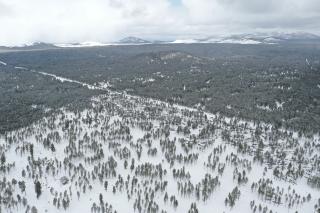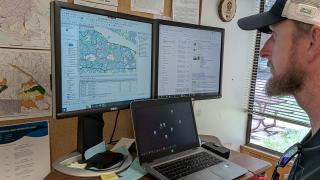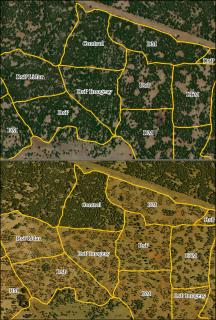
With a paint can in hand, a forester walks step by step through the dense Arizona ponderosa pine forest, marking trees with distinctive orange streaks. The forester is part of a timber-marking crew assessing if each tree should stay or go during harvest, per a prescription from the Forest Service silviculturist. Trees to remain receive the orange marking; the others will be harvested.
Timber-marking crews cover thousands of acres of Forest Service lands each year, prepping critical thinning projects to reduce the number of trees and move forest lands toward a condition less vulnerable to catastrophic wildfire. With this laborious operation, many began to ask: Couldn’t there be a more efficient way of marking trees?
The answer has come in the Coconino National Forest’s Walker Hill Demonstration Project with The Nature Conservancy—using digital tree marking methods. Results proved to be five times faster and 10 times less expensive, demonstrating how to get more done at less cost and in less time with a tablet in hand instead of a paint can.

Doing more with less
Across the West, the Forest Service is addressing landscapes defined as having high wildfire risk, with the Four Forest Restoration Initiative front and center. Since 2010, the Four Forest Restoration Initiative has implemented fuel reduction on the Coconino, Kaibab, Apache-Sitgreaves and Tonto national forests while emphasizing innovation to modernize the timber industry.
Getting more done with less is crucial for the Coconino National Forest to thin small-diameter ponderosa pine forests before a wildfire occurs.
“It’s like we're racing the clock to get the acres treated before fire does it for us,” said Flagstaff Ranger District Silviculturist Mark Nabel on the Coconino National Forest. “We want to ramp up.”
Acres must be systematically prepped—layout, tree marking, and cruising—prior to thinning treatments. The Flagstaff Ranger District prepped 5,000 acres a year in the past but is pressing to triple this to 15,000 acres per year. The question, then, is how?
“We needed to find more efficient ways to get timber sales prepped,” Nabel said. “This is what led to these digital alternatives.”
Introducing digital marking
In cooperation with the Forest Service, The Nature Conservancy worked for several years to test digital marking, using a variety of methods and technologies.
“Dollars or person power will not always meet the scale of the challenges, but applying more efficient practices can clearly help get us moving in the right direction,” said Forest Program Director Joel Jurgens from The Nature Conservancy’s Arizona chapter.
The 410-acre project completed in 2023 compared five tree designation methods in randomized treatment blocks to answer the efficiency piece—tablet or no tablet. Northern Arizona University supported the project design, data collection, and analysis.
By combining a field-based GIS app with high-resolution imagery, digital marking on a tablet made it easier for field-based crews to visualize what the forest would look like after cutting.
“Having such a clear picture of what the forest looks like on the tablet evolved into this other idea of, ‘If you can really picture what the forest looks like that clearly from just a map, do you even need to be out in the woods or can you make some of these decisions about where to leave groups of trees from the office?’” Nabel explained.
Jurgens added, of the defining results: “Tested on several other projects, digital marking seemed to move much quicker than painting trees, but the work on the Walker Hill Demonstration Project has finally quantified this. The savings with both time and dollars have exceeded our expectations.”
Reducing costs, keeping efficiency
Digital-based layout methods can significantly reduce costs during project preparation without sacrificing efficiency during implementation, all while achieving desired end results. Digital methods, where the desired end result is described to the operator, require a highly trained logger, adequate oversight during cutting, and applied where the forest type and prescription complexity allow.
Digital marking also allows flexibility for the operator more than paint-based approaches do to find efficiencies. Suarez Forestry, the skilled logging operator in this project, had prior digital experience across various terrains—flat and sloped—that equipped it to demonstrate that potential.
“When we have paint on trees, we are expected to do exactly what the mark says. The value [of digital marking] is the flexibility for the operator to not be handcuffed by the actual physical paint on the tree,” said Devon Suarez, president of Suarez Forestry of Heber, Arizona.
Digital marking, instead, guides the operator how to implement a prescription while allowing for operational concerns like how to navigate the terrain or turn equipment around in the woods. “The operator is more efficient in how to move around the trees,” Suarez added.

Digital win-win
Overall, use of digital designation methods is said to be a win-win. Digital methods allowed the Coconino National Forest to prep more acres—getting the Coconino closer to its 15,000-acre annual timber sale goal—and to offer more work to industry.
“The more volume we make available, the more contracts we can put out, the more industry we can keep,” Nabel said.
Digital-based layout methods continue to be used on the Four Forest Restoration Initiative forests, including the recently completed A-1 South timber sale on the Coconino where a digital prescription guide was created from desktop marking at the request of the operator. Digital methods are also to be used in the upcoming Pumphouse Community Projection Project on the Coconino and the Zero Timber Sale on the Kaibab.
No Forest Service mandates exist that loggers must use digital prescription guides; however, the Forest Service provides LiDAR maps and The Nature Conservancy provides the hardware, tablets and support for those interested.





